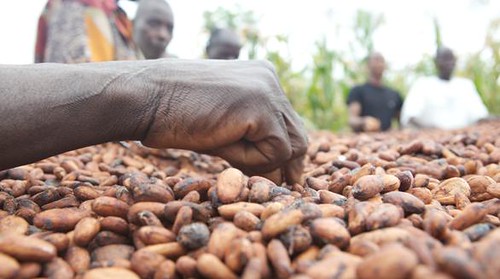Terroir refers to the environmental factors that influence the taste and quality of cocoa beans. In the case of Venezuelan cocoa beans, the terroir plays a crucial role in shaping their unique flavors and characteristics. The terroir of Venezuela is influenced by various factors, including climate, soil conditions, and altitude, which all have a direct impact on the flavor profile of the cocoa beans. For example, the warm and humid climate of Venezuela, combined with the rich volcanic soils, provides ideal conditions for cocoa cultivation, resulting in beans with a distinct flavor profile. The connection between terroir and flavor is particularly significant in the production of fine chocolates, where the origin of the cocoa beans is highly valued. Artisanal chocolatiers recognize and appreciate the influence of terroir on flavor and strive to showcase its impact in their chocolates.
To illustrate the significance of terroir, we can look at the example of cocoa beans from the Chuao region in Venezuela.Chuao is renowned for producing exceptional cocoa beans with a unique flavor profile. The terroir of Chuao, including factors such as the specific climate, soil conditions, and altitude, contributes to the exceptional flavors found in the cocoa beans grown in this region. The warm and humid climate, combined with the volcanic soils, creates the perfect environment for cocoa cultivation, resulting in beans with a complex and rich flavor profile. This example demonstrates how the terroir of Venezuela influences the flavor characteristics of cocoa beans, making them highly sought after by chocolatiers and chocolate enthusiasts.
Historical Importance of Venezuelan Cocoa Beans
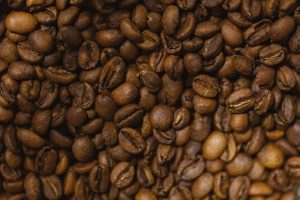

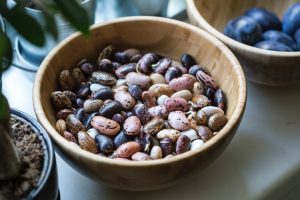
Venezuelan cocoa beans, especially those of the Criollo variety, have long been highly prized for their intense flavors.The historical significance of Venezuelan cocoa beans can be traced back to the days of the Spanish colonization, when Venezuela was one of the main suppliers of cocoa to the European market. The Criollo variety, known for its delicate flavor and aroma, was highly valued and considered a luxury product. Certain locations in Venezuela, such as Chuao, gained a reputation for producing exceptional cocoa beans. However, over time, the connection between chocolate and its place of origin has been somewhat lost. Crossbreeding and the cultivation of disease-resistant cacao trees have led to a blending of genetics and a dilution of the distinct flavors associated with specific regions. Additionally, changes in processing techniques have furthered the separation between cocoa beans and their origin.
The historical importance of Venezuelan cocoa beans is evident in the cultural heritage and identity associated with cocoa production in the country. In regions like Chuao, cocoa cultivation and processing have been passed down through generations, with traditional techniques still being practiced today. This rich history and tradition contribute to the unique flavors found in Venezuelan cocoa beans. Despite the challenges faced by the cocoa industry in recent years, the historical significance of Venezuelan cocoa beans continues to be recognized and celebrated by artisanal chocolatiers and chocolate enthusiasts around the world.
Rediscovering the Connection: Terroir in Artisanal Chocolatiers
Artisanal chocolatiers have played a significant role in rekindling the appreciation for terroir in chocolate production.These chocolatiers prioritize sourcing cocoa beans from specific regions known for their distinct terroir, recognizing that the flavor characteristics influenced by terroir, genetics, and processing methods add depth and complexity to their chocolates. By sourcing cocoa beans from specific origins, artisanal chocolatiers aim to create a sensory experience that connects consumers to the land where the cocoa beans were grown. This emphasis on quality and origin sets artisanal chocolates apart from mass-produced counterparts, as they strive to showcase the unique flavors associated with specific origins.
An example of an artisanal chocolatier that values terroir in chocolate production is Amano Artisan Chocolate. Amano sources cocoa beans from various origins, including Venezuela, and focuses on showcasing the unique flavors influenced by terroir. They believe that the specific growing conditions and environmental factors of each origin contribute to the distinctive flavors found in their chocolates. By carefully selecting cocoa beans from specific origins, Amano is able to create chocolates that reflect the essence of the land where the cocoa beans were grown, allowing consumers to experience the unique flavors associated with each origin. This emphasis on terroir sets Amano’s chocolates apart and appeals to chocolate enthusiasts who appreciate the complexity and depth of flavor that can be achieved through the influence of terroir.
Defining and Delineating Chocolate Origins
- Defining and delineating chocolate origins can be a complex task, as there is little agreement on how to approach this matter.
- The complexity arises from the blending of genetics in cocoa trees, resulting in a mix of varietal and origin characteristics.
- Moreover, the number and nature of prized origins can change based on growing conditions and the preferences of chocolatiers.
- The concept of chocolate origins encompasses a combination of factors, including terroir, genetics, and cultural heritage.
- This diversity of chocolate origins adds richness and variety to the flavors found in the chocolate industry.
- By recognizing and preserving the connection between chocolate and its place of origin, we can appreciate the complexity and uniqueness of flavors that different origins offer.
- The definition and delineation of chocolate origins are influenced by various perspectives and approaches.
- Some chocolatiers and experts focus on specific regions, such as Chuao in Venezuela or Madagascar, known for their exceptional cocoa beans with distinct flavor profiles.
- Others consider the genetic diversity within cocoa trees, recognizing that the blending of genetics contributes to the unique flavors found in cocoa beans.
- Additionally, cultural heritage and traditions associated with cocoa production are also taken into account when defining and delineating chocolate origins.
- By considering these various factors, chocolatiers and chocolate enthusiasts can appreciate the complexity and diversity of flavors that different origins offer, enhancing the overall chocolate experience.
Unique Characteristics of Chuao Cocoa
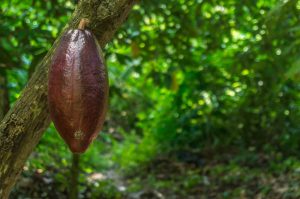

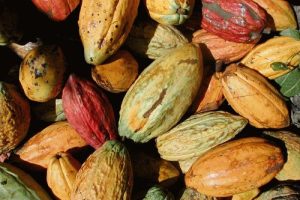
Chuao cocoa, a high-quality Criollo variety grown in Venezuela, stands out for its exceptional flavor. The unique soil conditions and microclimate found in Chuao contribute to the perfect growing conditions for cocoa. The volcanic soil, rich in minerals, provides essential nutrients for the cocoa trees, resulting in beans with a distinct flavor profile. The microclimate, with its warm and humid conditions, allows for the slow and even ripening of the cocoa pods, enhancing the development of complex flavors. The manual harvesting, drying, and fermentation processes of Chuao cocoa are meticulously carried out without the use of artificial additives or flavorings, allowing the natural flavors of the cocoa beans to shine through. The result is a cocoa bean with a complex flavor profile that is often described as floral, fruity, and with hints of nuts and spices.
Chuao cocoa represents more than just an agricultural product; it symbolizes the life, identity, and pride of the local indigenous people. The cocoa cultivation and processing techniques have been passed down through generations, with the knowledge and traditions preserved and practiced by the community. Recognizing the importance of preserving the authenticity of Chuao cocoa, it has been recognized as an appellation of origin (AO), protecting its name and restricting its use to the specific geographical area. This recognition ensures that the cocoa beans grown in Chuao are distinct from those grown in other regions and helps to maintain the integrity and reputation of the cocoa. The unique characteristics of Chuao cocoa, combined with its cultural significance, make it highly sought after by chocolatiers and chocolate connoisseurs who value the complexity and depth of flavor that it offers.
Impact of IP Protection and Branding
The recognition and protection of Chuao cocoa as an appellation of origin have proven effective in marketing and branding the cocoa. Amedei, an Italian chocolate producer, has registered the name “Chuao” as a trademark, preventing other chocolate producers from using the name. This protection has increased the income of local farmers and attracted foreign direct investment, providing economic benefits to the community. The success of Chuao cocoa is built upon the combination of quality, reputation, and effective branding. IP protection and branding have allowed Chuao cocoa to compete with mass-produced counterparts and sustain local rural communities.
The impact of IP protection and branding can be seen in the success of Chuao cocoa and the benefits it brings to the local community. By registering the name “Chuao” as a trademark, Amedei has established a strong brand identity and created a sense of exclusivity around their chocolates made with Chuao cocoa. This has allowed Amedei to differentiate their products from others in the market and command a higher price point. The protection of the Chuao name also ensures that the quality and reputation of the cocoa are maintained, as only chocolates made with genuine Chuao cocoa can bear the name. This has increased the income of local farmers in Chuao and has attracted foreign direct investment, leading to economic growth and development in the community. The impact of IP protection and branding extends beyond the economic benefits, as it also helps to preserve the cultural heritage and identity associated with Chuao cocoa.
Influence of Growing Conditions on Flavor
The country and region where cacao is grown and harvested significantly influence the flavor of chocolate. Factors such as terroir, genetics, and processing methods all contribute to the unique flavor characteristics of cocoa beans. Different regions around the world have established their reputation for producing cacao with distinct flavors. For example, Africa produces 70% of the world’s cacao, with countries like Madagascar and Tanzania known for their high-quality beans with fruity and tangy flavors. In the Americas, countries like Mexico, Peru, Ecuador, and Brazil produce fine cacao with its own unique flavor profile. Southeast Asia, including countries like Vietnam, Papua New Guinea, and Indonesia, is emerging as an important region for cacao production, contributing its own flavors to the global chocolate scene.
The influence of growing conditions on flavor can be observed in the case of Venezuelan cocoa beans. The warm and humid climate, combined with the rich volcanic soils, provides ideal conditions for cocoa cultivation in Venezuela. These growing conditions contribute to the development of flavors that are unique to the region. The flavor profile of Venezuelan cocoa beans is often described as rich, complex, and with notes of fruit, nuts, and spices. This distinct flavor profile is highly valued by chocolatiers and chocolate enthusiasts, who appreciate the depth and complexity that it adds to their chocolates. The influence of growing conditions on flavor highlights the importance of terroir and environmental factors in chocolate production.
Recognizing the Importance of Origin in Chocolate Production
Understanding the influence of terroir on cocoa beans from Venezuela highlights the significance of origin in chocolate production. The diverse flavors and experiences offered by chocolates from different origins enrich the chocolate industry. By valuing and preserving the connection between chocolate and its place of origin, we can appreciate the complexity and uniqueness of flavors that each origin brings. The rise of artisanal chocolatiers and the revisiting of terroir emphasize the importance of origin in the pursuit of high-quality chocolates. Exploring the flavors influenced by terroir allows us to discover the rich heritage and diversity behind cocoa beans from Venezuela and beyond.
The importance of origin in chocolate production can be seen in the growing interest and demand for single-origin chocolates. Single-origin chocolates are made with cocoa beans sourced from a specific region or plantation, allowing the unique flavors associated with that origin to shine through. Chocolatiers who prioritize origin in their chocolates aim to create a sensory experience that connects consumers to the land where the cocoa beans were grown. By understanding and appreciating the influence of terroir, genetics, and processing methods on flavor, consumers can explore the diverse flavors and experiences offered by chocolates from different origins. This not only adds richness and variety to the chocolate industry but also allows us to discover and appreciate the cultural heritage and diversity behind cocoa beans from Venezuela and beyond.
In conclusion, the influence of terroir on cocoa beans from Venezuela is undeniable. The environmental factors, including climate, soil conditions, and altitude, shape the terroir and have a direct impact on the flavor profile of the cocoa beans. Venezuelan cocoa beans, especially those of the Criollo variety, have a long history of being highly prized for their intense flavors. However, the connection between chocolate and its place of origin has been somewhat lost due to crossbreeding and changes in processing techniques. Artisanal chocolatiers have played a significant role in rediscovering and showcasing the influence of terroir, aiming to highlight the unique flavors of cocoa beans from specific origins. Defining and delineating chocolate origins can be complex, as it involves considering factors such as terroir, genetics, and cultural heritage. The unique characteristics of Chuao cocoa exemplify the impact of terroir on flavor, with its exceptional flavor profile influenced by the specific soil conditions and microclimate of the region. The recognition and protection of Chuao cocoa as an appellation of origin have had a positive impact on marketing and branding, benefiting the local farmers and attracting foreign direct investment. The influence of growing conditions on flavor can be observed not only in Venezuela but also in other regions around the world, each contributing its own distinct flavors to the global chocolate scene. Recognizing the importance of origin in chocolate production allows us to appreciate the complexity and uniqueness of flavors and experiences offered by chocolates from different origins. By valuing and preserving the connection between chocolate and its place of origin, we can continue to explore and celebrate the rich heritage and diversity behind cocoa beans from Venezuela and beyond.

